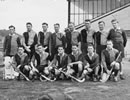Origins
By the time the British began to settle in New Zealand, cricket was well established in England, and its governing body was the Marylebone Cricket Club (MCC) in London.
While shepherds watched their flocks
Cricket probably evolved in the late 12th century in the English counties of Kent, Sussex, Hampshire and Surrey. It is believed that to break the boredom of watching their flocks, shepherds lobbed stones or hunks of matted wool at a companion who protected himself with a club cut off a tree. The Anglo-Saxon word ‘cricce’ means a crooked staff.
Aristocrats had begun paying cricketers in the 18th century, and cricket was strong in public schools and universities. It had also spread to villages and local clubs, and county cricket was beginning. The rules were established, straight bats and three stumps had become standard and teams normally had 11 members. Cricket was regarded as not only a game, but a system of manly ethics which expressed English superiority.
The first New Zealand games
In 1832 the missionary Henry Williams encouraged boys in the Church Missionary Society school at Paihia in the Bay of Islands to play cricket. Three years later Charles Darwin watched a game at nearby Waimate North.
Just over a year after their arrival in 1840 the settlers in Wellington were playing practice games, and in November 1842 the Wellington Cricket Club was formed. By 1851 cricket had also been played in Nelson, Auckland, Dunedin and Christchurch. However, in the 1840s and 1850s games were spasmodic and, although cricket appeared wherever the English settled, there were few regular contests.
What makes a team?
The composition of cricket teams in the early years revealed social distinctions. Some games pitted married men against singles – occasionally described as ‘bachelors versus benedicts’. Other games were played between military and civilians. Yet others highlighted class divisions. The first game in Christchurch in 1851 saw the local club (11 of whom were described in the score sheet as ‘Esquire’) play against a ‘Working Men’s XI’1.
Promoting the game
Initially gentlemen took the lead in organising and playing games. In Christchurch the first game was played in 1851 on Canterbury Anniversary Day (December 16), and involved a team led by the colony’s founder, John Robert Godley. Over the next five years the 41 players of the Christchurch Cricket Club included 15 members of the Provincial Council.
In the North Island the occasional games often involved British soldiers stationed in New Zealand. Their presence helped explain the increase in North Island cricket in the 1860s.
Growth further south was partly due to the gold rushes. Miners played cricket in Central Otago, and the wealth brought to Dunedin by the rushes allowed the draining of the southern Oval and the erection of a grandstand.
In 1864, the entertainment promoter Shadrach Jones enticed George Parr’s All England XI to come over from Australia and play an Otago team of 22 and later a Canterbury team of 22. Otago also played Canterbury in the country’s first domestic first-class game (a game between teams that have been designated by cricket’s governing body to meet a particular standard).
Progress against difficulties
Compared with rugby, which only needed a paddock and a pig’s bladder, playing cricket in colonial New Zealand was difficult. The rainy climate restricted play and made grounds rough and muddy. There were no rollers and mowers until late in the century and English grasses had to be sown. There was also little in the way of equipment at first, and there were no pads or gloves.
As cities grew, clubs became more established and cricket gained popularity. This created a shortage of grounds, especially in Wellington. The 1877 and 1881 Public Reserves acts prevented clubs charging admission. Nonetheless funds had to be poured into improving grounds at Carisbrook in Otago, the Basin Reserve in Wellington, and Lancaster Park in Canterbury.
The players
Early cricket games were as much social occasions as serious contests. After overarm bowling was legalised in 1864 many still bowled using less effective underarm or round-arm techniques. There was also plenty of alcohol and gambling at games.
The length of games and the expense of travel restricted the involvement of the working class. The Shops and Shop Assistants Act 1894 prescribing a Saturday half-holiday helped; but cricket remained a largely middle-class game. There were few Māori players and opposition to the suggestion that women might play.
Believing that cricket was an English game which trained boys in discipline and moral character, the elite secondary schools such as Christ’s College, Wanganui Collegiate and Wellington College were significant cricket nurseries.
The path to a national game
By the early 1880s there were 60 cricket teams in Dunedin.
Trade and business teams began in the cities, and with improvements in roads and railways, provincial games became more regular. By 1883 every main centre had established a provincial association to organise these contests.
Visiting teams from Australia and England received elaborate public receptions and created considerable spectator interest. Between 1876 and 1894 four English teams, three Australian, one Tasmanian and two private New South Wales teams toured most areas of New Zealand.
The first representative New Zealand team played New South Wales in Christchurch on 15 February 1894. This inspired the establishment in December that year of the New Zealand Cricket Council in Christchurch – where it remained. The Council’s job was to arrange international and provincial matches. It adopted the Marylebone Cricket Council’s official rules and chose the silver fern as its insignia.
By the 1890s cricket was considered to be New Zealand’s national game.

